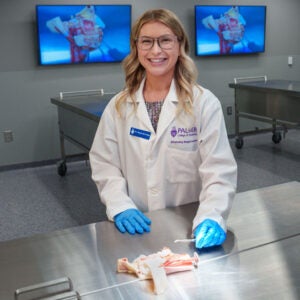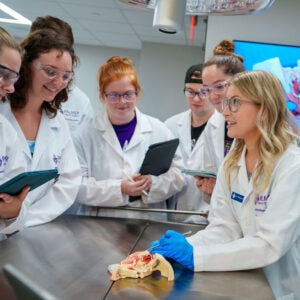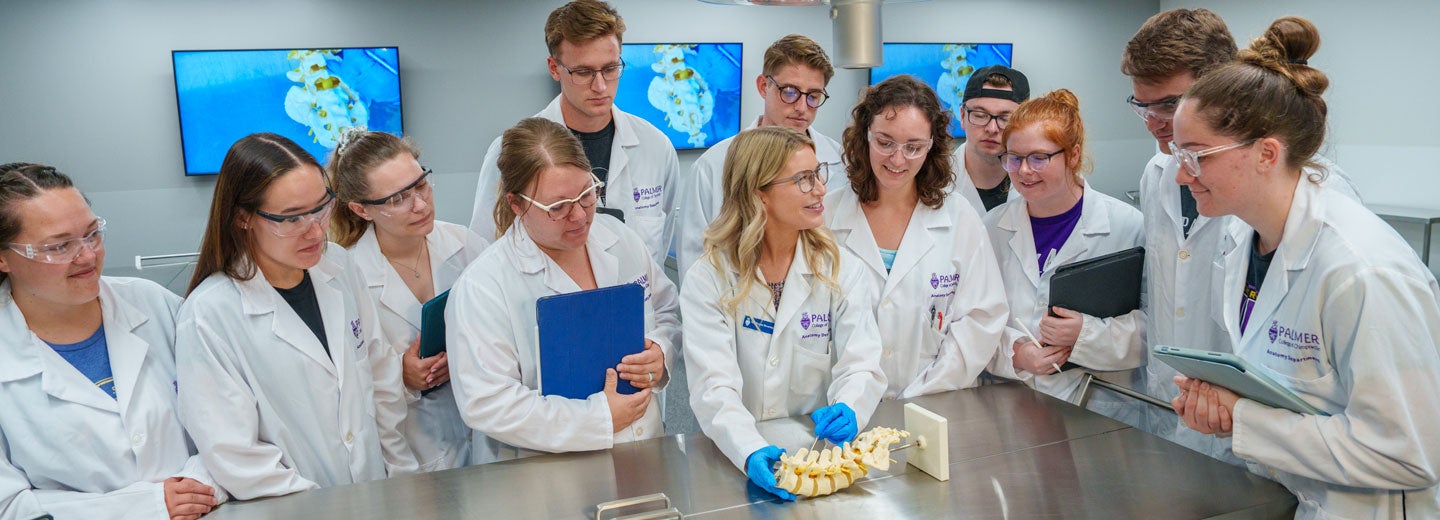 Megan Beveridge, M.S. is one of the faculty members who Palmer students get to know early in their academic career. During their second trimester, they spend six hours every week with Ms. Beveridge, learning about the joints, ligaments and muscles that attach along the axial skeleton.
Megan Beveridge, M.S. is one of the faculty members who Palmer students get to know early in their academic career. During their second trimester, they spend six hours every week with Ms. Beveridge, learning about the joints, ligaments and muscles that attach along the axial skeleton.
“Every week my students break into small groups and rotate between the wet lab where they study the musculature and ligaments on human specimens, the dry lab where they study bones, and then in a lecture setting where we use Complete Anatomy (augmented reality) as a study tool,” says Megan.
Megan and her students are early users of Palmer’s new wet and dry labs in Kiernan Hall, the Anatomy & Technique Center, which opened in 2022. The space allows students to easily move between new wet and dry labs equipped with monitors and cameras for easy, up-close viewing.
“One of the most rewarding things for me as an instructor is to see students not only master the material, but also become more comfortable studying a real human body in the wet-lab environment. While some of my students start the term a little hesitant about the wet lab, they really gain confidence. It’s when we really start to see that shift in mindset from beginner student to doctor.”
This foundational class sets students up for future classes where they learn how to study, read X-rays and set the stage for developing their hands-on adjusting skills.
“I’ve had students come back to me after they completed my class and tell me how helpful it was to take spinal anatomy and learn the various regions of the vertebral column and osseous features from different views, because it really does benefit them as they get on into their academic careers,” she explains.
 Spinal anatomy is one of the classes taken before the NBCE Part I boards, a four-part series of licensure exams a Doctor of Chiropractic student must pass to earn their license to practice.
Spinal anatomy is one of the classes taken before the NBCE Part I boards, a four-part series of licensure exams a Doctor of Chiropractic student must pass to earn their license to practice.
“In my course, we talk about joints and movements allowed from the axial skeleton. This has to do with how our vertebrae articulate with one another, with how our ribs articulate with our vertebrae, what types of joints are located along the spine and to take it a step further, what types of movements those joints allow. All of this prepares students to succeed as they take that first big step toward earning their licensure and caring for patients.”
The Palmer student pass-rate for NBCE Part 1 national exams is 91.3%, more than 20% higher than the national average, and their pass rate for the spinal anatomy section of the boards is 98.1.

 Megan Beveridge, M.S. is one of the faculty members who Palmer students get to know early in their academic career. During their second trimester, they spend six hours every week with Ms. Beveridge, learning about the joints, ligaments and muscles that attach along the axial skeleton.
Megan Beveridge, M.S. is one of the faculty members who Palmer students get to know early in their academic career. During their second trimester, they spend six hours every week with Ms. Beveridge, learning about the joints, ligaments and muscles that attach along the axial skeleton. Spinal anatomy is one of the classes taken before the NBCE Part I boards, a four-part series of licensure exams a Doctor of Chiropractic student must pass to earn their license to practice.
Spinal anatomy is one of the classes taken before the NBCE Part I boards, a four-part series of licensure exams a Doctor of Chiropractic student must pass to earn their license to practice.